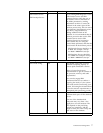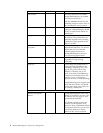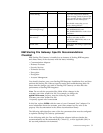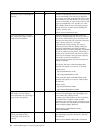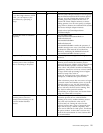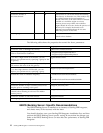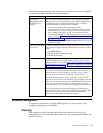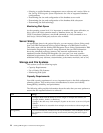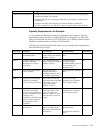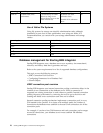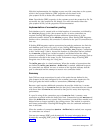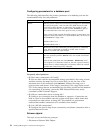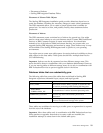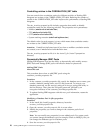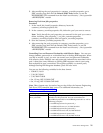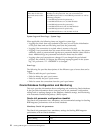
Goal Strategy
Scalability and Performance
v Configure the disk array with many small disks instead of a few large disks to
increase the number of I/O paths.
v Configure the disk array with large NVRAM cache to improve read and write
performance.
v Configure the disks with stripping (for example, RAID-0 or RAID-10).
v In some circumstances, you may also want to consider using solid-state disks.
Capacity Requirements: An Example
Let us consider the following example to understand the concept of capacity
requirements better. Assume you require 900 GB of storage and you have disk
arrays or SANs that are made up of 93 GB disks. Let us further assume that the
database is implemented over ninety 10 GB data files.
The following table summarizes the choices for the common disk organizations
and the trade-offs involved.
Technology Scalability Survivability Maintainability Num Disks
JBOD Poor. Subject to throughput
of individual disks
Poor. Single-disk failure
creates outage and requires
database recovery
Poor. High disk utilization
skew.
10
RAID-0 Excellent. Striping n disks
provides read/write
throughput at n times a
single disk.
Poor. Single-disk failure
creates outage and requires
database recovery.
Excellent. Expect
near-uniform disk
utilization within a logical
unit. Potential LUN
utilization skew.
10
RAID-1 Poor. Similar performance
to that of JBOD.
Better. Can survive
multiple disk failures,
assuming that these occur
in different mirrored sets.
Poor. High disk utilization
skew.
20
RAID-5 Excellent for read (similar
to RAID-0). Potentially
poor for write performance.
Better. Able to survive a
single-disk failure. Multiple
disk failures create an
outage and require
database recovery.
Excellent. Low disk
utilization skew. Possible
LUN utilization skew.
11
RAID-6 Excellent for read (similar
to RAID-0). Potentially
poor for write performance
as parity calculations need
to happen. The
performance of RAID-6 and
RAID-5 is about the same
and dependent on the
controllers.
Better. Can survive a
double-disk failure. This
gives it an edge over
RAID-5. A failure of more
than two disks creates an
outage.
Excellent. Low disk
utilization skew. Possible
LUN utilization skew.
12
RAID-01 Excellent read/write
performance.
Can tolerate up to two disk
failures as long as both
failures are not in the same
mirrored set.
Excellent. Low disk
utilization skew.
Possible LUN utilization
skew.
20
Performance Management 15



